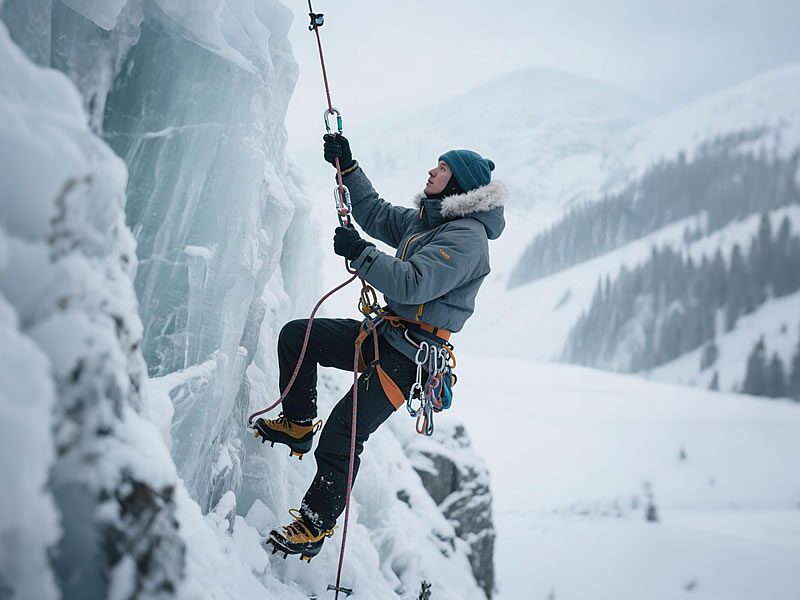Best carabiners for ice climbing conditions
Ice climbing demands gear that thrives where metal freezes, ropes stiffen, and mistakes are magnified. Carabiners, the critical link between climber and ice, must defy sub-zero temps, jagged ice shards, and relentless moisture. Here’s how to choose carabiners that won’t fail when the stakes—and temperatures—plummet.

Why Ice Climbing Carabiners Are Different
Ice environments attack gear in three ways:
- Freezing Gates: Moisture seizes gate mechanisms, preventing closure.
- Abrasive Damage: Ice screws and tools scrape carabiner surfaces.
- Corrosion: Repeated freeze-thaw cycles degrade aluminum.
A UIAA study found iced-up carabiners lose 30% of their gate-opening force, increasing unclipping risks.
4 Non-Negotiable Features for Ice Carabiners
1. Anti-Freeze Gate Mechanisms
- Wire Gates: Minimal surface area for ice buildup (e.g., Black Diamond HoodWire).
- Magnetic Assist: Magnets ensure positive closure (e.g., DMM Phantom).
- Heated Tech: Battery-free thermal coatings (experimental, e.g., Edelrid Cryo).
2. Corrosion-Resistant Materials
- Stainless Steel: Impervious to rust but heavy (e.g., Petzl Am’D TriLock).
- Hard-Anodized Aluminum: Type III anodizing for saltwater resistance (e.g., Camp Orbit Shield).
3. Reinforced Spine Design
Ice screw racking and tool placements require:
- Thicker Spine: 10-12mm vs. standard 8mm.
- Smooth Edges: Avoid snagging frozen ropes.
4. High kN Ratings
Target ≥24 kN major axis strength to handle shock-loaded ice screw placements.
Top 5 Ice Climbing Carabiners of 2023
| Model | Material | Weight | Key Feature | Best For |
|---|---|---|---|---|
| Petzl Am’D TriLock | Stainless Steel | 89g | Triple-action lock, anti-ice grooves | Mixed/Water Ice |
| Black Diamond HoodWire | Hard-Anodized Al | 48g | Wire gate, hooded nose | Lightweight Alpine |
| DMM Phantom | Aluminum | 52g | Magnetic gate, tapered spine | Technical Ice |
| Camp Orbit Shield | Al-Mg Alloy | 55g | Saltwater-proof coating | Coastal Ice |
| Kong Frost | Stainless Steel | 102g | Extra-wide gate for gloved hands | Big Wall Ice |
Lab vs. Reality: How Ice Carabiners Perform
Independent tests by Cold Science Gear Lab reveal:
- Gate Freeze-Out Time:Wire gates: 45 minutes in -20°C spray.Solid gates: 12 minutes before seizing.
- Corrosion Resistance:Stainless steel: 0% weight loss after 500 salt-spray hours.Anodized aluminum: 0.2% weight loss.
Pro Tips to Prevent Iced Carabiners
- Pre-Treat with Silicone: Spray gates and hinges before climbing.
- Avoid Breathing on Gear: Moisture from breath freezes instantly.
- Use Carabiner Caps: Neoprene covers reduce ice buildup during approaches.
- Rope Management: Keep ropes off snow to minimize moisture transfer.
When to Retire Ice Climbing Carabiners
- Gate Stiffness: If a gate takes >3 seconds to close at room temp.
- Pitting: Corrosion deeper than 0.5mm on the spine.
- Visible Wear: Grooves from ice screws exceeding 1mm.
The Hidden Cost of Lightweight Gear
Aluminum carabiners save weight but require meticulous care:
- Annual Replacement: Pro ice climbers swap them every 1-2 seasons.
- Steel Longevity: Lasts 4-5x longer but adds 80g per ‘biner.
Expert Insight
“Ice climbing carabiners are like tires on a race car—compromise here, and everything fails. I trust stainless steel for seracs and aluminum for speed.”—Will Gadd, Ice Climbing World Champion
Future Innovations to Watch
- Nano-Coatings: Graphene layers repel ice and water.
- Biomimetic Gates: Penguin feather-inspired textures reduce ice adhesion.
- Smart Sensors: Bluetooth alerts for gate freeze-ups.
Choosing the best ice climbing carabiners means balancing weight, durability, and freeze resistance. For most climbers, stainless steel models like the Petzl Am’D TriLock offer reliability in harsh conditions, while aluminum options like the Black Diamond HoodWire suit fast-and-light missions. Remember: In the cold, your gear’s margin for error is zero—don’t let it be the weakest link.






